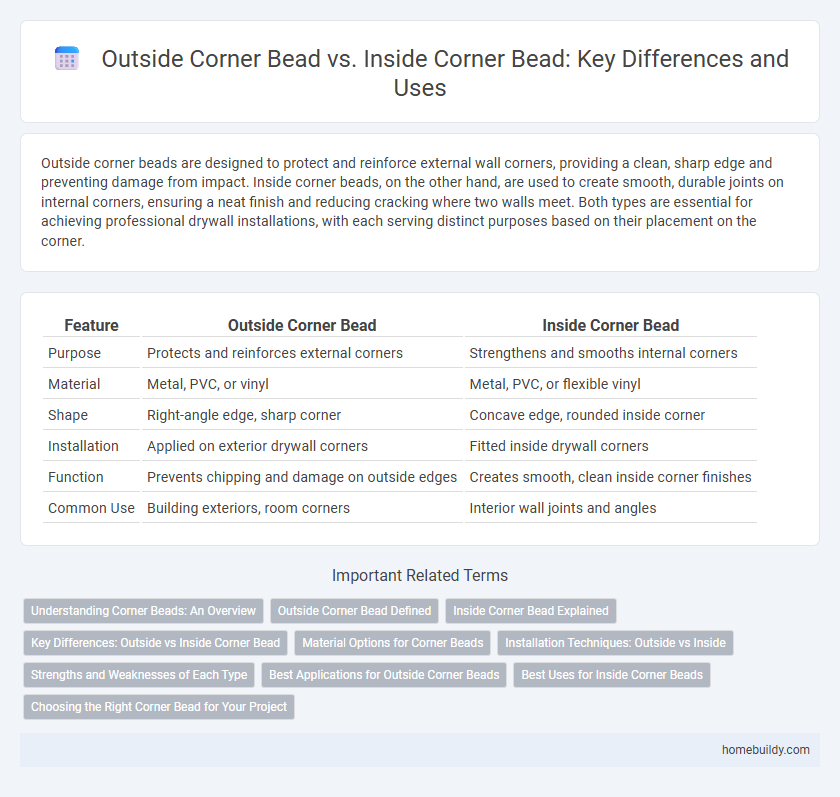Outside corner beads are designed to protect and reinforce external wall corners, providing a clean, sharp edge and preventing damage from impact. Inside corner beads, on the other hand, are used to create smooth, durable joints on internal corners, ensuring a neat finish and reducing cracking where two walls meet. Both types are essential for achieving professional drywall installations, with each serving distinct purposes based on their placement on the corner.
Table of Comparison
| Feature | Outside Corner Bead | Inside Corner Bead |
|---|---|---|
| Purpose | Protects and reinforces external corners | Strengthens and smooths internal corners |
| Material | Metal, PVC, or vinyl | Metal, PVC, or flexible vinyl |
| Shape | Right-angle edge, sharp corner | Concave edge, rounded inside corner |
| Installation | Applied on exterior drywall corners | Fitted inside drywall corners |
| Function | Prevents chipping and damage on outside edges | Creates smooth, clean inside corner finishes |
| Common Use | Building exteriors, room corners | Interior wall joints and angles |
Understanding Corner Beads: An Overview
Outside corner beads reinforce and protect the external edges of drywall, providing a crisp, clean finish while preventing damage from impact. Inside corner beads are designed to create smooth, durable joints at internal drywall corners, ensuring a seamless transition between adjoining walls. Both types are essential for achieving professional-quality drywall installations and enhancing wall durability.
Outside Corner Bead Defined
Outside corner bead is a metal or vinyl strip applied to reinforce and protect the external corners of drywall installations, ensuring durability and clean, sharp edges. It is designed to be attached on the outside angles where two drywall panels meet, providing resistance against impact and wear. This type of corner bead is essential for maintaining the structural integrity and aesthetic appeal of outer wall corners in residential and commercial construction.
Inside Corner Bead Explained
Inside corner bead is a drywall finishing material designed to reinforce and smooth the internal angles where two walls meet, ensuring a clean, durable corner. Made from materials such as metal, vinyl, or paper-faced metal, it provides a crisp edge that resists cracking and damage from everyday impact. Proper installation of inside corner bead improves the overall finish quality, enhances durability, and simplifies the painting or wallpapering process on interior corners.
Key Differences: Outside vs Inside Corner Bead
Outside corner bead is designed to reinforce and protect external edges of walls, providing a sharp, clean finish for corners exposed to impact and wear. Inside corner bead fits internal wall angles, ensuring a smooth, crisp joint that enhances the strength and appearance of recessed corners. The primary difference lies in their application: outside corner beads shape external angles while inside corner beads stabilize internal angles, both crucial for drywall durability and aesthetics.
Material Options for Corner Beads
Outside corner beads are typically made from durable materials such as galvanized steel, aluminum, and PVC to provide strong protection against impacts and wear on external corners. Inside corner beads often use flexible vinyl or paper-faced metal to accommodate slight irregularities and ensure smooth, clean interior corner finishes. Material selection depends on the corner's exposure, durability requirements, and desired aesthetic outcomes.
Installation Techniques: Outside vs Inside
Outside corner bead installation requires precise alignment along external edges, typically secured with nails or screws, then finished with joint compound for a smooth, durable corner. Inside corner bead placement demands careful embedding into recessed angles, often using metal or flexible vinyl beads, and reinforced with joint tape to prevent cracking in interior corners. Proper handling of these distinct techniques ensures structural integrity and a flawless finish in drywall installations.
Strengths and Weaknesses of Each Type
Outside corner beads provide durable protection and a sharp, clean edge for drywall corners, enhancing resistance to impacts and wear. Inside corner beads allow for smooth, precise joints in interior corners, facilitating seamless finishes but are more prone to cracking under stress or movement. Both types require proper installation to optimize their strength and minimize vulnerabilities based on corner placement.
Best Applications for Outside Corner Beads
Outside corner beads provide critical protection and reinforce the durability of drywall corners, preventing cracks and chips in high-traffic areas such as hallways and living rooms. They are best applied on exterior edges where walls meet to create sharp, clean lines and withstand impact. Choosing galvanized steel or PVC outside corner beads ensures long-lasting resistance to moisture and corrosion, ideal for both residential and commercial projects.
Best Uses for Inside Corner Beads
Inside corner beads are best used for reinforcing and finishing interior drywall corners, ensuring crisp, clean edges that resist cracking. Made from materials like metal or vinyl, they provide stability and protect vulnerable inside angles from damage and wear. Their design accommodates tight corners, making them essential for achieving a smooth, professional look in interior drywall installations.
Choosing the Right Corner Bead for Your Project
Selecting the right corner bead for your project involves understanding the differences between outside and inside corner beads; outside corner beads reinforce and protect external corners from damage, while inside corner beads provide a smooth, clean finish for internal angles. Material choices such as galvanized steel, PVC, or metal mesh impact durability and suitability depending on moisture exposure and surface type. Accurate measurements and consideration of corner angles ensure optimal adhesion and long-lasting performance in drywall or plaster applications.
Outside corner bead vs Inside corner bead Infographic

 homebuildy.com
homebuildy.com